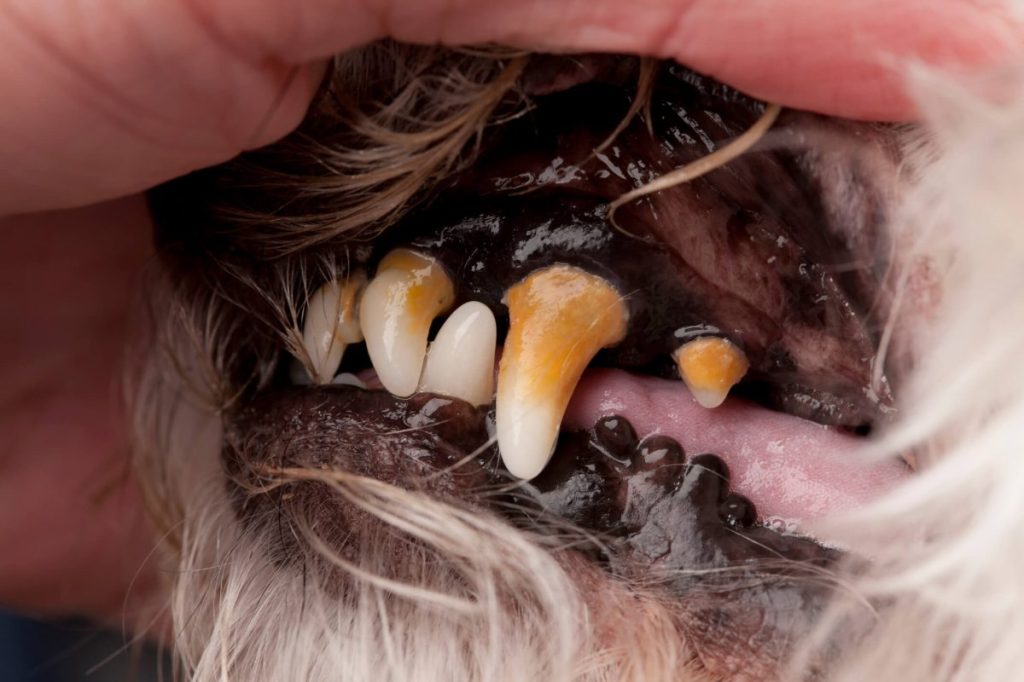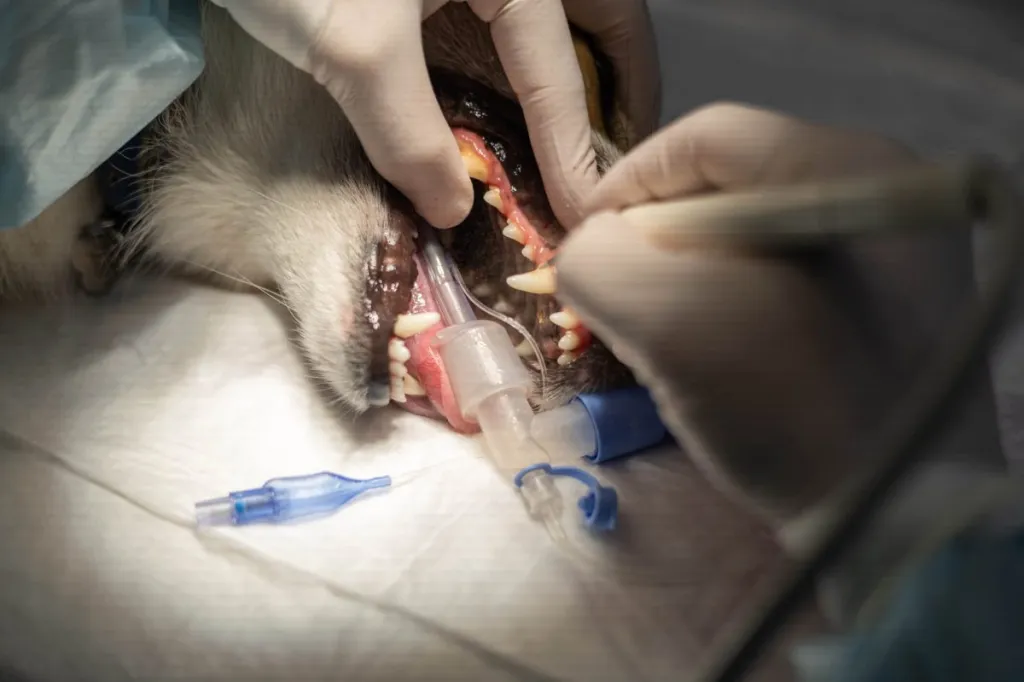Periodontal Disease in Dogs: Symptoms, Causes, & Treatments

Periodontal disease — also known as gum disease — is an inflammatory condition that affects the structures surrounding a dog’s teeth, including the gums, periodontal ligament, and alveolar bone. It starts with plaque buildup, which hardens into tartar if not removed. Over time, this can lead to infection, gum recession, and even tooth loss. According to the American Veterinary Dental Society, periodontal disease is the most common dental condition in dogs, affecting over 80% of canines over the age of three.
Here’s what you should know about the symptoms, causes, and treatments for the disease in dogs.
Symptoms of periodontal disease in dogs

Periodontal disease in dogs progresses through various stages:
- Stage 1 or gingivitis: This is the earliest stage, marked by inflamed gums that may appear red and swollen. Gums may also bleed easily, especially during brushing or chewing hard foods. At this stage, periodontal disease is reversible with proper dental care.
- Stage 2 or early periodontitis: In this stage, there is the beginning of attachment loss, where the gums start to recede, forming pockets around the teeth. There might be mild bone loss, and bad breath becomes noticeable.
- Stage 3 or moderate periodontitis: As the disease progresses, these pockets deepen, leading to more significant bone loss and damage to the supporting structures of the teeth. The dog’s discomfort may become more apparent, and teeth may start to loosen.
- Stage 4 or advanced periodontitis: This is the most severe stage, where extensive bone loss and deep periodontal pockets are present. Teeth may become very loose or fall out, and the dog can experience significant pain, difficulty eating, and severe infection that can spread to other parts of the body.
Early-stage periodontal disease may present with subtle symptoms that can be easy to overlook. That’s why you must regularly inspect your dog’s mouth for anything out of the ordinary. Common signs to watch out for include:
- Red, swollen, or bleeding gums
- Bad breath (halitosis)
- Reluctance to eat or chew
- Excessive drooling
- Visible tartar buildup on teeth
As the disease progresses, more severe symptoms may emerge, such as:
- Loose or missing teeth
- Abscesses or pus around the teeth
- Receding gums
- Pain or discomfort, leading to behavioral changes
Causes of periodontal disease in dogs

The main cause of periodontal disease in dogs is the accumulation of plaque and tartar on the teeth. Bacteria in the mouth form a biofilm on the tooth surface, which eventually mineralizes into tartar if not regularly removed. Several factors can increase a dog’s risk of developing periodontal disease, including:
- Age: Older dogs are more prone to periodontal disease due to prolonged exposure to plaque and tartar buildup.
- Breed: Small and toy breeds are particularly susceptible due to the anatomy of their mouths, which often leads to overcrowded or misaligned teeth.
- Diet: A diet consisting predominantly of soft or sticky foods can contribute to plaque accumulation.
- Oral hygiene: Inadequate dental care, such as infrequent tooth brushing or lack of professional cleanings, can exacerbate the problem.
Treatments for periodontal disease in dogs

Treating periodontal disease involves a combination of professional veterinary care and diligent at-home maintenance. Initially, your veterinarian will conduct a thorough physical examination, often accompanied by dental X-rays to assess the extent of the disease beneath the gum line. Depending on the stage or severity of the disease, the treatment plan can include the following:
- Professional dental cleaning: A professional dental cleaning is often the first step in treating periodontal disease. This procedure involves scaling to remove plaque and tartar from your dog’s teeth, both above and below the gum line. Your dog will need to be under anesthesia to ensure thorough cleaning and to reduce stress.
- Antibiotics: If your dog’s periodontal disease is accompanied by infection, your veterinarian may prescribe antibiotics to combat the bacterial infection and reduce inflammation. This is especially important in more advanced stages where the infection might have spread deeper into the gums and jawbone.
- Tooth extraction: In severe cases, some teeth may be too damaged to save and will need to be extracted. While this might sound drastic, removing severely affected teeth can significantly improve your dog’s overall oral health and comfort.
- Surgical treatment: Sometimes, surgical procedures might be necessary for stage 4 periodontal disease. These can include flap surgery to clean deep pockets of infection or bone grafts to restore lost bone structure. Your vet will discuss the best course of action based on the specific needs of your dog.
Prevention of periodontal disease in dogs

Periodontal disease can cause irreversible damage, but if you stop it early, you can minimize or prevent that damage. As such, preventing periodontal disease is far easier and less costly than treating it. Here’s how you can keep your dog’s teeth and gums healthy:
- Regular brushing: One of the most effective ways to prevent periodontal disease is to brush your dog’s teeth regularly. Ideally, this should be done daily, but even a few times a week can make a significant difference. Use a dog-specific toothbrush and toothpaste, as human products can be harmful to pets.
- Dental chews and toys: Providing your dog with dental chews and toys can help clean their teeth naturally. These products are designed to reduce plaque and massage the gums, promoting better oral health. Look for products that have the Veterinary Oral Health Council (VOHC) seal of approval. This indicates they meet standards for plaque and tartar control.
- Healthy diet: A balanced diet that includes dental health benefits can also be helpful. Some commercial dog foods are specifically formulated to reduce plaque and tartar buildup.
- Routine vet visits: Regular veterinary check-ups are essential for early detection and prevention of periodontal disease. Your vet can examine your dog’s teeth and gums for any signs of trouble. Aim for at least one dental check-up per year.
While periodontal disease itself is not directly life-threatening, it can significantly impact your dog’s overall health and quality of life if left untreated. Chronic periodontal disease can lead to severe pain and infections that may spread to other parts of the body, including the heart, liver, and kidneys. However, with proper treatment and preventive care, many dogs with periodontal disease can live long and healthy lives.







